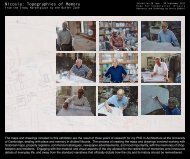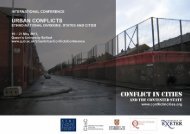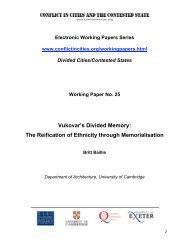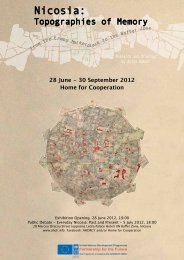Post-conflict reconstruction in Mostar: Cart before the Horse
Post-conflict reconstruction in Mostar: Cart before the Horse
Post-conflict reconstruction in Mostar: Cart before the Horse
You also want an ePaper? Increase the reach of your titles
YUMPU automatically turns print PDFs into web optimized ePapers that Google loves.
Several thousand residents of <strong>Mostar</strong> died as a result of <strong>in</strong>terethnic hostilities between<br />
1992 and 1995, <strong>in</strong>clud<strong>in</strong>g combatants and non-combatants. Dur<strong>in</strong>g <strong>the</strong> same period, as<br />
many as 40,000 prewar residents left <strong>the</strong> city altoge<strong>the</strong>r <strong>in</strong> order to avoid <strong>the</strong> violence,<br />
about 10,000 male residents were forcibly deta<strong>in</strong>ed <strong>in</strong> local prisoner camps and more than<br />
30,000 rema<strong>in</strong>ed <strong>in</strong> <strong>the</strong> city but were compelled to leave <strong>the</strong>ir homes. In eastern <strong>Mostar</strong><br />
between 1993 and 1995, supplies of food, heat<strong>in</strong>g fuels and medic<strong>in</strong>e were consistently low<br />
and irregular, lead<strong>in</strong>g to a predicable set of health problems. Citizens collect<strong>in</strong>g dr<strong>in</strong>k<strong>in</strong>g<br />
water along <strong>the</strong> eastern bank of <strong>the</strong> river attracted sniper fire from <strong>the</strong> surround<strong>in</strong>g hills, and<br />
<strong>the</strong>y were also likewise threatened cross<strong>in</strong>g bridges or travers<strong>in</strong>g open spaces on essential<br />
errands. Though <strong>the</strong> number of <strong>Mostar</strong>ians physically <strong>in</strong>jured or severely traumatised by <strong>the</strong><br />
violence is not known, it can be assumed that few local families emerged from <strong>the</strong> war<br />
unsca<strong>the</strong>d and resid<strong>in</strong>g <strong>in</strong> <strong>the</strong>ir pre-war homes.<br />
The costs of violence and separation between rival ethnic groups <strong>in</strong> <strong>Mostar</strong> are more<br />
neatly calculated <strong>in</strong> material terms. The physical destruction or <strong>in</strong>accessibility of many<br />
schools, offices, homes, factories, and public <strong>in</strong>frastructure <strong>in</strong> <strong>Mostar</strong> dur<strong>in</strong>g <strong>the</strong> course of<br />
hostilities left its citizens <strong>in</strong> <strong>the</strong> eastern sector struggl<strong>in</strong>g for bare survival and economic life<br />
<strong>in</strong> <strong>the</strong> western sector dom<strong>in</strong>ated by illicit trade. Thousands of immigrants forced to abandon<br />
surround<strong>in</strong>g villages arrived <strong>in</strong> <strong>the</strong> city, occupy<strong>in</strong>g empty apartments and stra<strong>in</strong><strong>in</strong>g <strong>the</strong><br />
already overburdened <strong>in</strong>frastructure.<br />
As a regional capital and one of Bosnia’s major manufactur<strong>in</strong>g cities, <strong>Mostar</strong> was harshly<br />
affected by general lapses <strong>in</strong> national productivity dur<strong>in</strong>g <strong>the</strong> war. Economic growth rates<br />
were halved with <strong>the</strong> outbreak of <strong>in</strong>terethnic hostilities, dipp<strong>in</strong>g towards -27% by <strong>the</strong> end of<br />
1993, while <strong>the</strong> adjusted gross domestic product fell precipitously from $13.1 billion <strong>in</strong> 1990<br />
to $6.2 billion <strong>in</strong> 1993. iii Theft, expulsion, and bombardment generated massive property<br />
losses. Hundreds of Bosniak families from western <strong>Mostar</strong> were obliged to abandon <strong>the</strong>ir<br />
homes with what <strong>the</strong>y could carry, or less, leav<strong>in</strong>g <strong>the</strong> bulk of <strong>the</strong>ir possession beh<strong>in</strong>d for<br />
looters or black market profiteers.<br />
For purposes of defence, <strong>the</strong> Bosniak residents protect<strong>in</strong>g <strong>the</strong> historic eastern portion of<br />
<strong>the</strong> city aga<strong>in</strong>st attacks by <strong>the</strong> Croatian paramilitary forces established a front-l<strong>in</strong>e along <strong>the</strong><br />
Austro-Hungarian Boulevard approximately 100 meters west of <strong>the</strong> river. This l<strong>in</strong>e divided<br />
<strong>the</strong> city <strong>the</strong> physically and functionally from May 1993 until <strong>the</strong> sign<strong>in</strong>g of <strong>the</strong> Dayton Peace<br />
Accords <strong>in</strong> late 1995. It can be easily argued that <strong>the</strong> city rema<strong>in</strong>s somewhat segregated<br />
along this l<strong>in</strong>e up to <strong>the</strong> present, though diplomats are quick to po<strong>in</strong>t out that full legal and<br />
adm<strong>in</strong>istrative <strong>in</strong>tegration was achieved several years ago through <strong>the</strong> susta<strong>in</strong>ed efforts of<br />
6







